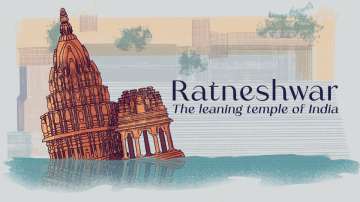When you hear about any leaning architecture, it is so clear that you are mentally shifted to Italy, remembering the Leaning Tower of Pisa. This is entirely justified if you are unaware of Varanasi's leaning temple, which has surpassed the leaning tower in terms of tilting. Keep reading further to explore some fascinating facts and fables associated with Kashi Karvat or Ratneshwar temple.
Varanasi, the temple hub of India, is nothing less than a divine place on earth. Thousands of temples in the holy city of Varanasi are a treat for your eyes and soul, but the leaning temple of Ratneshwar Mahadev deserves a special mention. There are a lot of unique features and mysteries surrounding the temple, just like the pristine water surrounding it. Yes, you heard it right. Due to its conspicuously low level, it is flooded most of the year.
Ratneshwar: The leaning temple of India
This traditional temple is dedicated to Lord Shiva, who is worshipped as Matr-rin Mahadev(a form of Shiva). The elegant architecture includes a Nagara Shikhara (high curve shape) and a Garbhagriha (sanctum). And don’t be surprised if I say that the Garbhagriha is engulfed by water during most of the period, and sometimes the water level even reaches the Shikhara. An English scholar, James Prinsep, claimed that when the temple entrance was drowned in water, a priest would dive into the water to perform the worship and other rituals.
Ratneshwar Temple is nestled near the Manikarnika Ghat in Kashi. Due to its location and leanness, this is also called the Kashi Karvat (Lean in Kashi). According to reports, the temple leans at 9 degrees, which is significantly greater than the 4 degrees lean of the Torre Pendente di Pisa (Leaning Tower of Pisa). The temple, on the other hand, was not always this way and once stood upright in the past.
Ratneshwar: The leaning temple of India
When we look at old pictures of the temple, we can see that it was erected straight before the 1860s, but then the ghat collapsed for unknown reasons, tilting the temple backward. The actual time of construction is unknown, and its erector remains debatable. Dr Ratnesh Varma, of the District Cultural Committee, claims that the structure was constructed by the Amethi royal family. However, there are other interesting legends related to the tilt.
According to a legend, Ratneshwar Temple was built by a servant of Raja Man Singh. He decided to construct this temple as a token of love for his mother, Ratna Bai, and to demonstrate his obligation to her. After a few years of hard work and effort, the temple was completed, and the man proudly declared that he had paid his mother's debt. But, do you believe a mother's debt can ever be paid off? The moment he spoke such words, the temple bent backwards, signifying that a child is always indebted in front of his mother.
(This article is attributed to Swapna Roul, storyteller at ThisDay by Ekank Technologies)
(Disclaimer: The opinions expressed in this article are those of the author. They do not reflect the views of India TV)
